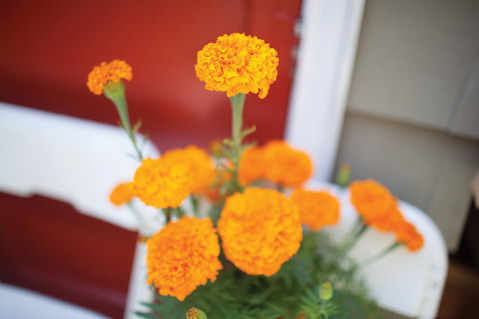Mighty Marigolds
From Herbal Remedies to Decorative Uses

For months on end, one of the few flowering annual plants that reliably appears on nursery and home-improvement-center gardening aisles is the marigold. The bright yellow-orange balls of petals have seemingly been around forever. In fact, though, the marigold is one of the flowers to have been domesticated and improved on for longer than many others.
The ancestral marigold hails from southern Mexico or Central America and was included in the Aztec herbal as early as the 1500s. While there are references to the marigold as a cure for hiccups or to protect from lightning strikes, it was apparently more highly regarded for its decorative value. There is even some reason to believe that these early horticulturists did some selection and development of the species to produce larger flowers. They used the blossoms to decorate their holy places, and, eventually, it became one of the major components of tributes to the dead. Modern Mexicans erect altars to honor their dead each hallows’ eve, and marigolds are widely featured on them as well as on the graves of their dear departed friends and family members.
When the Portuguese and Spanish explorers arrived on the scene, they appropriated anything that suited their fancy, including the marigold. From their introduction to Europe, marigolds then spread to India and other parts of Asia. The brilliant color appealed to many cultures, and the flowers have become widely used there, as well. In India, marigold garlands are a standard decoration for tributes to the lesser gods.
In the increasingly incredible tale of marigolds’ journey from the jungles of Mexico to a North American garden center, their next stop was northern Africa. Spanish settlers took them along, and they were soon moving out of their cultivated garden plots and naturalizing in the countryside. Here, they shot up and developed new strains that were taller and more robust.
Once again, marigolds were collected and returned to their ancestral continent, where North American hybridizers have been working to realize their full potential for about 100 years. Chief among those early hybridizers was David Burpee. By the 1920s, his company (founded by his father W. Atlee) was featuring them in its catalog and funding research into further development. There are now odorless marigolds (yeah, the originals are kind of stinky) and many new petal and color forms, as well as the much-sought-after white marigold.
True plant hybridizers are never satisfied; there is always some unattained goal to pursue. For David Burpee, it was a pure white marigold. He had already spent $250,000 to develop such a rarity when, out of frustration, he offered a prize to anyone who could make a white marigold. After 21 years of submitting her seeds for consideration, Alice Vonk of Sully, Iowa, was finally awarded the $10,000 prize in 1975. Her hybrid, now sold under the moniker “Snowball,” is still one of the few white marigold varieties available.
Marigolds may have garnered their original renown because of their golden hue, but they are more famous now because of a Midwest gardener who persevered without the support of an industry devoted to developing new plant varieties, but worked in the soil of her own backyard.



